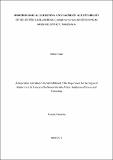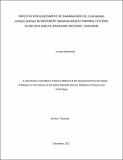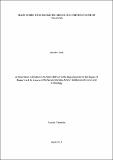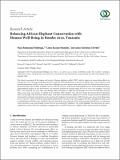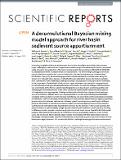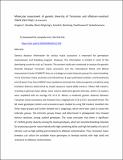Search
Now showing items 1-10 of 22
Evaluation of maize accessions for diversity, yield and tolerance to maize lethal necrosis disease in Tanzania
(NM-AIST, 2017-12)
Maize (Zea mays L.) is among the most important crops in Tanzania with still low average yield of 1.2 metric tonnes per hectare as compared with potential yields of 4 to 5 metric tonnes per hectare. Low yield is due to a ...
Morphological screening and farmers’ acceptability of selected lablab bean (lablab purpureus) accessions in Moshi district, Tanzania
(NM-AIST, 2019-04)
A set of 41 lablab bean accessions were evaluated based on morphological characteristics and farmers’ participatory selection was performed based on agronomic and sensory traits. An experimental plot was laid down in ...
Detection and management of phytophthora infestans on tomato in Iringa and Arusha regions, Tanzania
(NM-AIST, 2019-04)
A study was conducted in Iringa and Arusha regions of Tanzania to determine the status of the of Late blight disease (LBD) on tomato and effect of synthetic fungicides on the disease. Leaf samples with symptoms of the LBD ...
Extracts from Field Margin Weeds Provide Economically Viable and Environmentally Benign Pest Control Compared to Synthetic Pesticides
(Plos One, 2015-11-23)
Plants with pesticidal properties have been investigated for decades as alternatives to synthetics,
but most progress has been shown in the laboratory. Consequently, research on
pesticidal plants is failing to address ...
The potential of field margin pesticidal plants on bean production and ecosystem services in Arusha, Tanzania
(NM-AIST, 2017-12)
An experiment was undertaken in NM-AIST farms in Arusha Tanzania from January to July 2017 to assess the potential of pesticidal plants on supporting the beneficial insects, controlling pests’ and influencing bean growth ...
Infestation assessment of banana weevil (cosmopolites sordidus germar) in different banana-based farming systems in Arusha and Kilimanjaro regions, Tanzania
(NM-AIST, 2017-12)
The present study was conducted to determine population size, infestation level and farmer’s understanding of banana weevils in different banana-based farming systems (BFS) namely banana monoculture, banana-beans, banana-coffee ...
Maize store‒time marketing model for northern zone of Tanzania
(NM-AIST, 2019-04)
This study was carried out to create a marketing model that integrate maize store-time with five storage methods namely Perdue Improved Cowpeas Storage bags (PICS), Metal Drums, Kihenge, Polyethylene bags with insecticides ...
Balancing African Elephant Conservation with Human Well-Being in Rombo Area, Tanzania
(Hindawi Advances in Ecology, 2017-05-31)
The critical assessment of the nature and extent of human-elephant conflict (HEC) and its impact on conservation efforts are
essential if we are to meet the challenges related to extinction of local population, as well ...
A deconvolutional Bayesian mixing model approach for river basin sediment source apportionment
(Scientific Reports, 2018-08-30)
Increasing complexity in human-environment interactions at multiple watershed scales presents
major challenges to sediment source apportionment data acquisition and analysis. Herein, we present
a step-change in the ...
Molecular assessment of genetic diversity of Tanzanian and aflatoxin-resistant maize (Zea mays. L) accessions
(Springer International Publishing, 2024-05-28)
Genetic distance information for various maize accessions is important for germplasm improvement and breeding program. However, this information is limited in most of the developing countries such as Tanzania. The present ...


